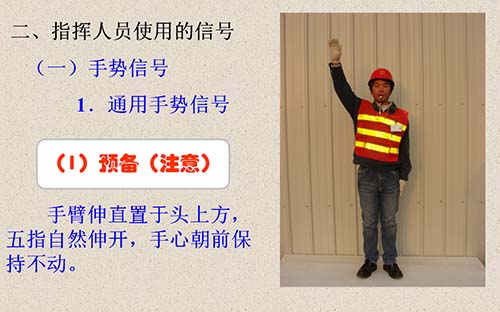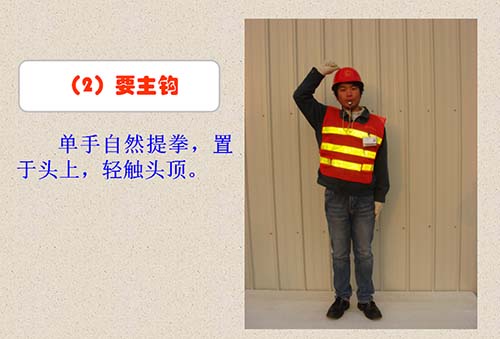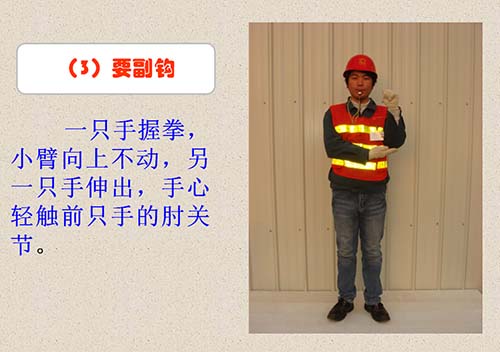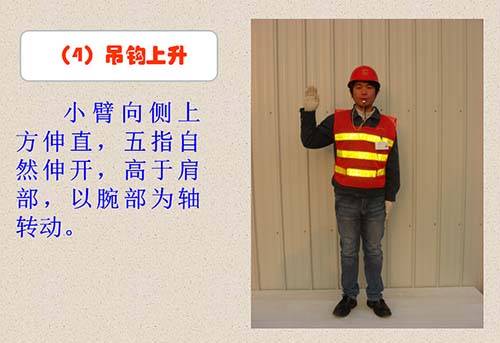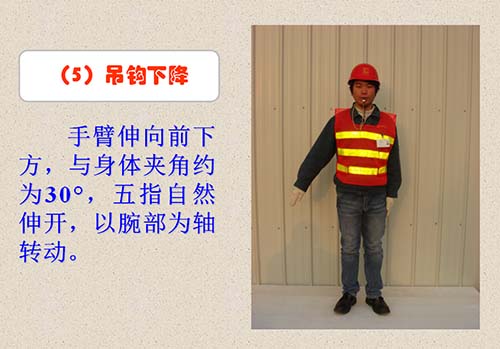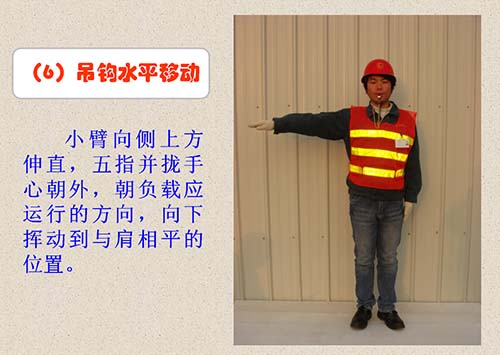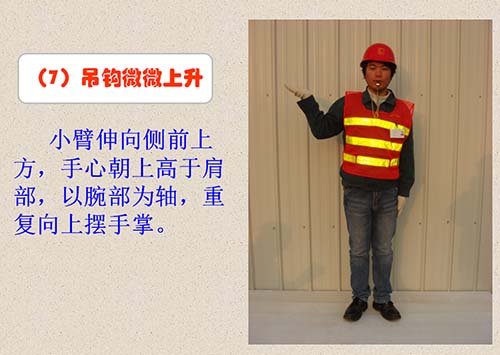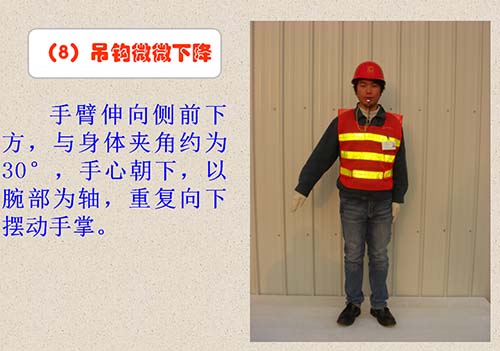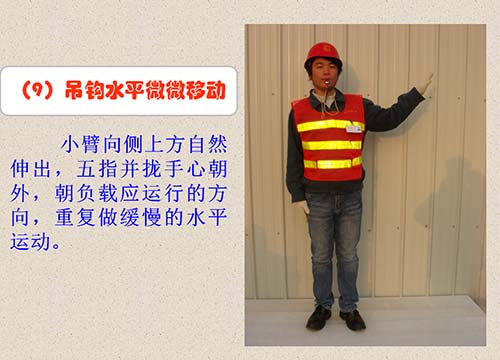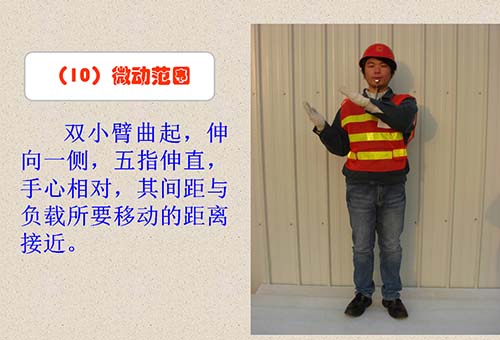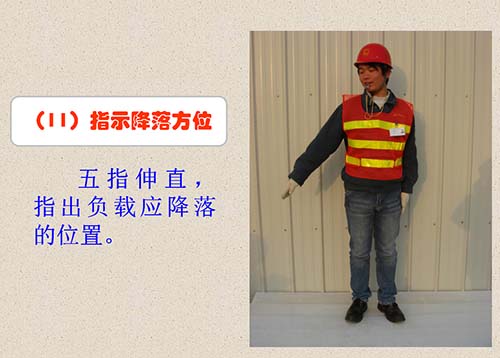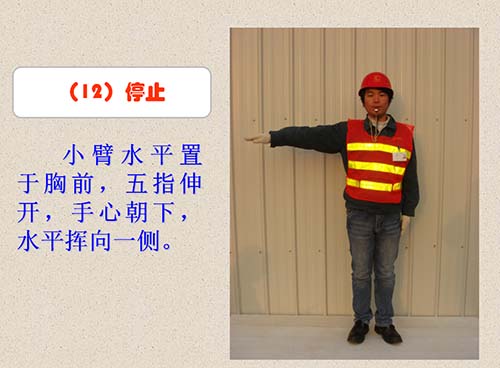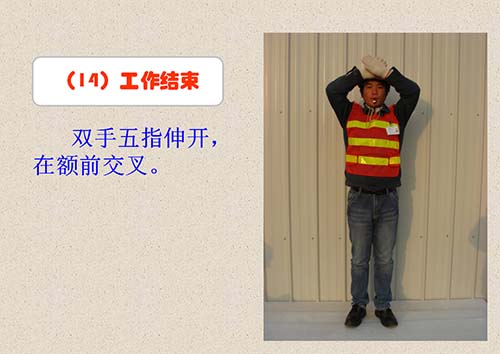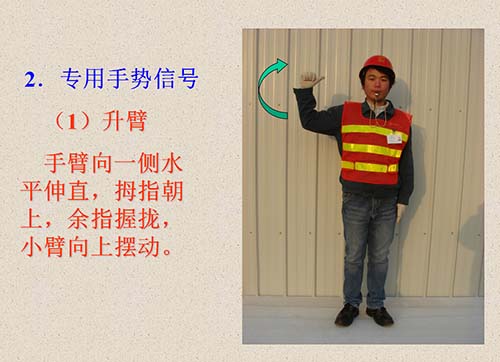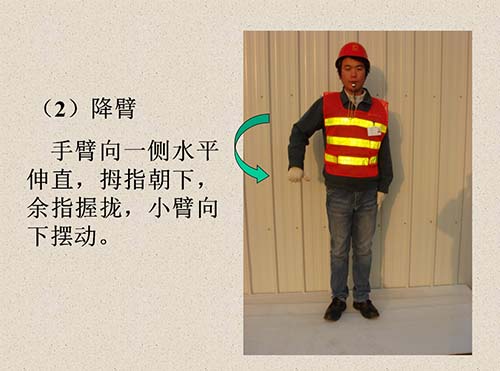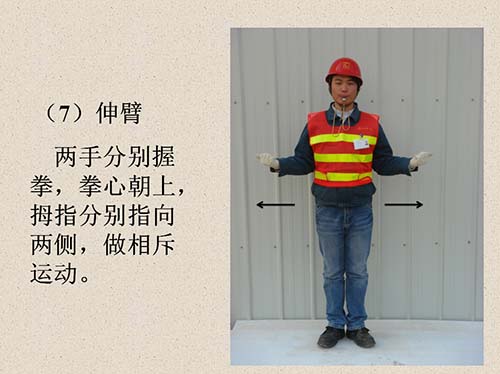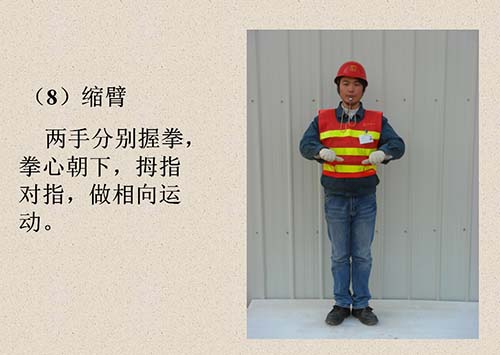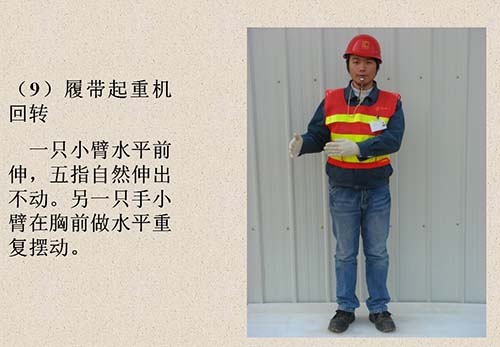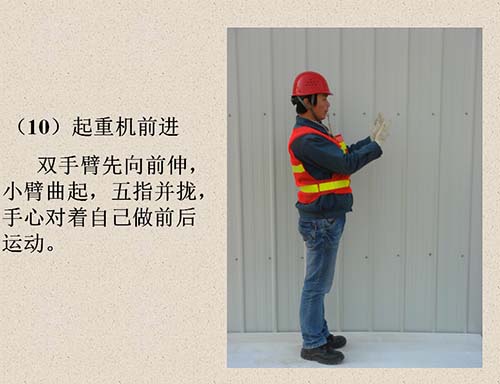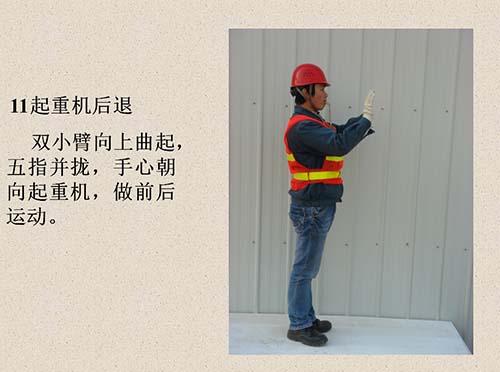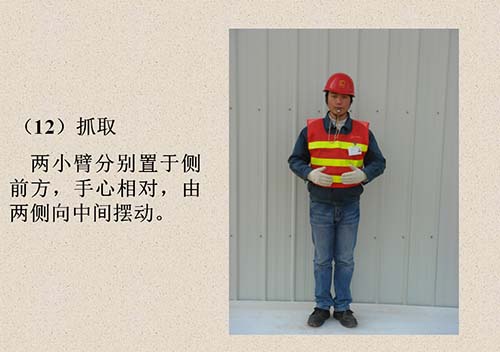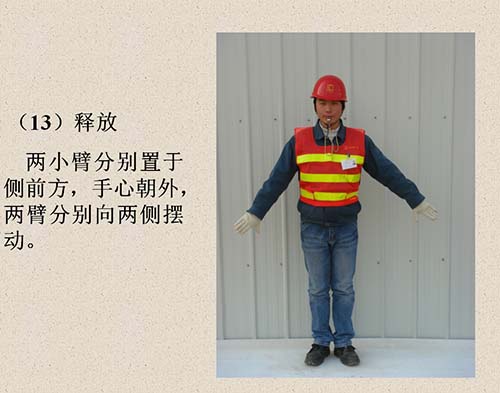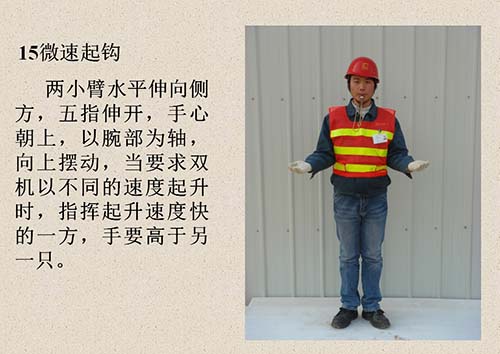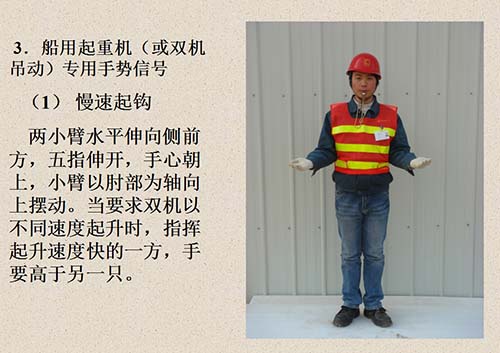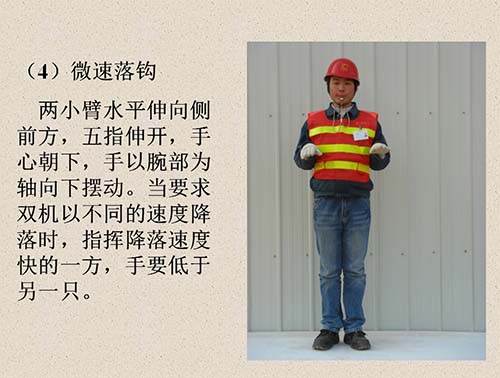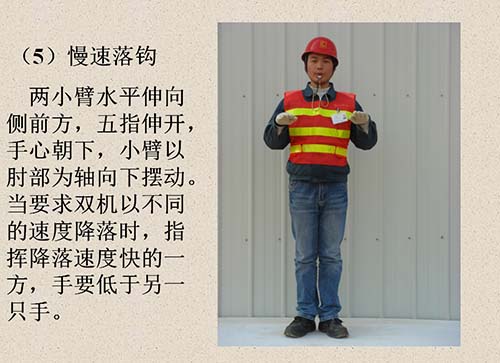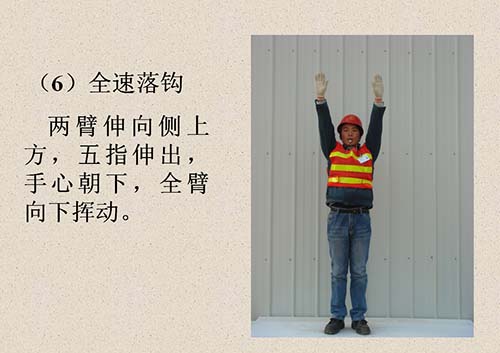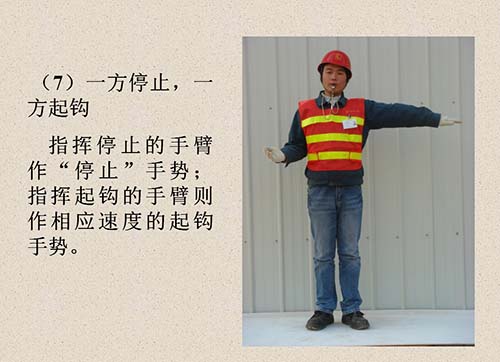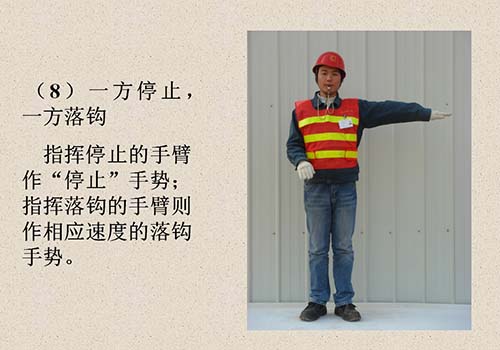Special operations are prone to casualties and cause great harm to the safety of operators, others, and surrounding facilities and equipment. The biggest reason for this is the lack of safety knowledge, poor safety operation skills, or illegal operations. Crane instruction gestures teaching graphics and hope to be helpful to everyone. First: Generic Gesture Signals - refers to the command gestures commonly used by various types of cranes in lifting cranes. Preparation: The arm is stretched above the head, fingers are stretched naturally, and the palm of the hand stays still. To master the hook: One hand naturally raises fists, places it on the head, and touches the top of the head. To deputy hook: one hand fist, the arm does not move up, the other hand stretched out, palms touch the elbow of the front hand. Hook up: The arm is extended straight to the side, the five fingers stretch naturally, higher than the shoulder, and rotate around the wrist. The hook is lowered: the arm extends forward and down, and the included angle with the body is about 30°. The five fingers naturally extend and rotate around the wrist. Horizontal movement of the hook: the arm is extended straight to the side, the five fingers close together and the palm of the hand is facing outwards, and in the direction that the load should run, it is swung down to the level with the shoulder. The hook slightly rises: the arm extends to the side of the upper front, the palm of the hand rises upwards above the shoulder, and the wrist is taken as the axis, and the palm of the hand is repeatedly swung upwards. The hook slightly descends: the arm extends to the front and the lower side, and the angle between the body and the body is approximately 30°, and the palm of the hand is turned downwards, with the wrist as the axis, and repeatedly swinging the palm downward. The horizontal movement of the hook is slight: the arm is naturally extended to the lateral side and the five fingers are close together and the palm of the hand is facing outwards. Repeatedly doing a slow horizontal movement toward the direction in which the load should operate. The fretting range: the double arm is curved and extends to one side. The fingers are straight and the palms are opposite. The distance between them is close to the distance that the load needs to move. Indicating the landing position: Five fingers stretched out to indicate where the load should land. Stop: The arm is placed horizontally on the chest, with fingers stretched out, palms facing down, and swinging horizontally to one side. Emergency stop: The two arms are horizontally placed on the chest, fingers stretched out, palms facing down, and swinging horizontally to both sides. The end of the work: hands stretched out and crossed before the forehead. Second: Dedicated gesture signal Lifting arm: The arm is stretched horizontally to one side, the thumb is upward, the other fingers are held together, and the arm is swinging upwards. Falling arm: The arm is stretched horizontally to one side, the thumb is down, the other fingers are held together, and the arm is swinging downwards. Swing arm: The arm is stretched horizontally, pointing in the direction of the arm to be turned. The thumb is extended, the other fingers are held, and the wrist is rotated as the shaft. Slightly raised arm: One arm placed on the side of the chest, fingers straightened, palms facing down, keeping still. The thumb of the other hand is facing the palm of the previous hand, and the other fingers are held and moved up and down. Slightly descending arm: One arm is placed on the side of the chest, fingers are straightened, palms are facing upwards, and remain stationary. The thumb of the other hand is facing the palm of the previous hand and the other fingers are held together and moved up and down. Arm extension: Two hands each make a fist and the boxing heart is facing upwards. The thumb points to both sides, doing a repulsive movement. Shrinking arm: Two hands each make a fist, the boxing heart is down, the thumb is on the finger, and the opposite movement is done. Crawler crane slewing: A small arm extends horizontally, and the five fingers naturally move out. The other arm of the other hand makes a horizontal repetitive swing on the chest. The crane advances: The two arms first stretch forward, the arms are bent, the fingers are close together, and the palms move back and forth in front of one another. The crane retreats: The double arms are bent upwards, the five fingers are close together, and the palm of the hand is facing the crane. Grabbing: The two arms are placed in front of the side and the palm of the hand is opposite, swinging from the sides to the middle. Release: The two arms are placed in front of the side and the palms are facing outwards. The arms swing to the sides. Flip: An arm bent forward, palm up. The arm of the other hand extends forward, with the palms facing down, and both hands are flipped at the same time. Slow-speed hooking: The two arms extend horizontally to the side, with fingers stretched out, palms facing upwards, with the wrist as the axis, swinging upwards, and commanding the double-lift to rise at different speeds, commanding the person with fast lifting speed, Hand is higher than the other. Third: Special gesture signal for marine crane (or double crane) Slowly lift the hook: the two arms extend horizontally to the front, the fingers are stretched out, the palms are upward, and the arm swings in the axial direction of the elbow. When it is required that the two aircrafts rise at different speeds, the commanding party with a faster speed of rise should have a higher hand than the other. At full speed: The arms are hanging down, fingers are stretched out, palms are facing upwards, and arms are waving upwards. Slowly falling hook: the two arms extend horizontally to the front, fingers stretched out, palms facing down, and the hand swings down with the wrist as the axis. When it is required that the two planes land at different speeds, the party that commands the faster landing speed should have lower hand than the other. Slowly falling hook: The two arms extend horizontally to the front, fingers stretched out, palms facing down, and the arm swings down in the direction of the elbow. When it is required that the two planes land at different speeds, the party that commands the fast landing speed should be lower than the other hand. Full-speed drop hook: The two arms reach the side of the upper part, the five fingers are extended, the palms are down, and the whole arm swings downwards. One side stops and one side hooks: the arm that directs the stop makes a “stop†gesture; the arm that directs the hook makes a hook gesture that corresponds to the speed. One side stops and one side falls: the arm that directs the stop makes a "stop" gesture; the arm that commands the off hook makes a downward-hook gesture that corresponds to the speed. Underwater Lift Bags,Buoyancy Airbags,Marine Salvage Lift Bag,Salvage Airbags Shandong Nanhai Airbag Engineering Co., Ltd. , https://www.nanhaimarine.com